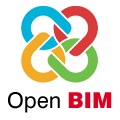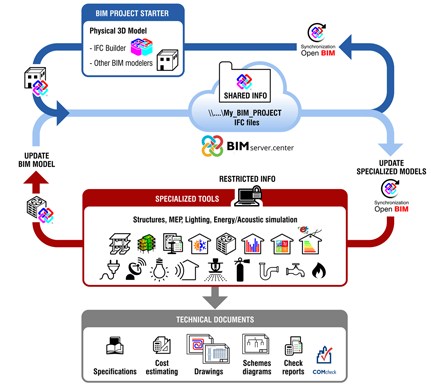
Using Open BIM technology a collaborative, multi-disciplinary and multi-user workflow can be implanted, which allows projects to be developed in an open, coordinated and simultaneous manner amongst the various project designers or agents that intervene in the project.
The work methodology proposed by CYPE is different to workflow proposals based on previously existing BIM tools available on the market. This webpage displays the workflow proposed by CYPE, in which the contents of the BIM project are not linked to any specific application or program.
Open BIM technology as a project tool
Using Open BIM technology a collaborative, multi-disciplinary and multi-user workflow can be implanted, which allows projects to be developed in an open, coordinated and simultaneous manner amongst the various project designers or agents that intervene in the project. In this workflow, proposed by CYPE, the project is solved in an iterative manner using the progressive solving of its various aspects or components.
This way of working is different to that proposed in the workflows based on BIM tools that previously existed in the market. Using these tools, the project is carried out based on the adopted solutions, in such a way that the work of the project designers who have to make project decisions based on loose and specific analysis models solved using specific applications.
The main property of Open BIM technology and, we believe, its main advantage is that it is based on open and public standard interchange formats (IFC), so that the contents of the BIM project are not linked to any specific application or program. Furthermore, thanks to the use of these interchange formats, the specific applications used to solve the various aspects of a project (structure, installations, etc.) do not have to be linked to a single software manufacturer.
The stages or actions contemplated in the workflow that is proposed to develop a project are:
- Beginning of the BIM project
- Use of specialised applications to solve the project
- BIM model update in specialised applications
- Export of IFC files to the BIM project
- Consolidation of the BIM model
Beginning of the BIM project
Based on an IFC file generated by IFC Builder or another modelling software (it does not necessarily have to be exclusively geometrical). To begin the BIM project, an empty directory has to be selected, since all the information that is deposited in the directory, as the project advances, will be interpreted as being part of the same BIM project.
Use of specialised applications to solve the project
All the applications can load the BIM model and work on it. Users must bear in mind that, some applications, can begin the development of the project without the need to have to be linked to a BIM model and create the link later on. For example, with CYPELEC REBT, users can begin the design of the electrical installation to then link it with a BIM model, later on when it is available, to introduce the floor plans on the model.
It is important to take into account that the analysis models of the various specialised applications are not loaded onto the shared or public BIM model. For example, in the case of CYPETHERM LOADS, the job or project of the program belongs to the designer that has performed the thermal load analysis, and no other project designer has access to the data file of CYPETHERM LOADS. This proposed workflow property is very important when assigning the responsibilities corresponding to all the technical staff that intervenes in the project.
BIM model update in specialised applications
Once the link with the BIM model has been created with the specialised applications, and with having begun the various projects, changes can be carried out on the model. The way in which CYPE applications react to the changes in the model to which they have been linked is one of the distinguishing and advanced properties of the Open BIM workflow.
In the proposed workflow, the specialised applications do not import a BIM model, since an import would imply that each time a change is carried out in the model, the work would have to be redone from the start. CYPE programs, which have been designed for this, UPDATE BIM models in such a way that if there are any changes in the original model, only work that has been carried out which remains obsolete after these changes is lost, and always with the user’s supervision, using the available update options.
Export of IFC files to the BIM project
As has been explained previously, the design models which manage the various specialised applications belong to the project designer that has created them and are not shared in the BIM project (they belong to the private field of each user). However, and this is a very important property of our applications, all of them can export an IFC file with information of each application. This way, the BIM project, after taking on this information, is progressively enriched and completed.
The information generated by the various applications can be, generally, of two types: it can be linked to entities that have been introduced previously in the BIM project (e.g. thermal loads generated by CYPETHERM LOADS which are linked to the precincts of the BIM project), or can consist of new project entities (e.g. the radiators or radiant floor circuits created in CYPETHERM HVAC).
Consolidation of the BIM model
Therefore, as the project is developed, the information corresponding to the BIM model increases using the IFC files generated by the specialised files. This is what we refer to as consolidation of the BIM model.
This, in reality, is very simple. The only thing to bear in mind is that the BIM model is not only the original IFC file, but it also consists of another file and of all the other files generated by the various specialised applications. This way, the BIM model which users work on includes all the consolidated information that has been generated amongst the specific applications that have been used.
This proposed workflow property allows for two very important, and very different, things to occur: on one hand the consolidations allows for interaction between the different specialised applications (e.g. CYPETHERM HVAC reads the thermal loads of the precincts that have been generated in CYPETHERM LOADS) and on the other, it unlinks the contents of the BIM project from the applications that have been used to develop it (the BIM project is not a file that belongs to a program, it is a collection of IFC files) and so this way the durability and accessibility of the developed work is guaranteed.
Requirements in the Open BIM workflow
The applications can generate requirements and errors in the Open BIM workflow:
- Requirements
The requirements must be solved using other applications, to complete the project satisfactorily. - Errors
Errors refer to elements of the model that have been placed by other applications, which must be modified to complete the project satisfactorily.

Tel. USA (+1) 202 569 8902 // UK (+44) 20 3608 1448 // Spain (+34) 965 922 550 - Fax (+34) 965 124 950


